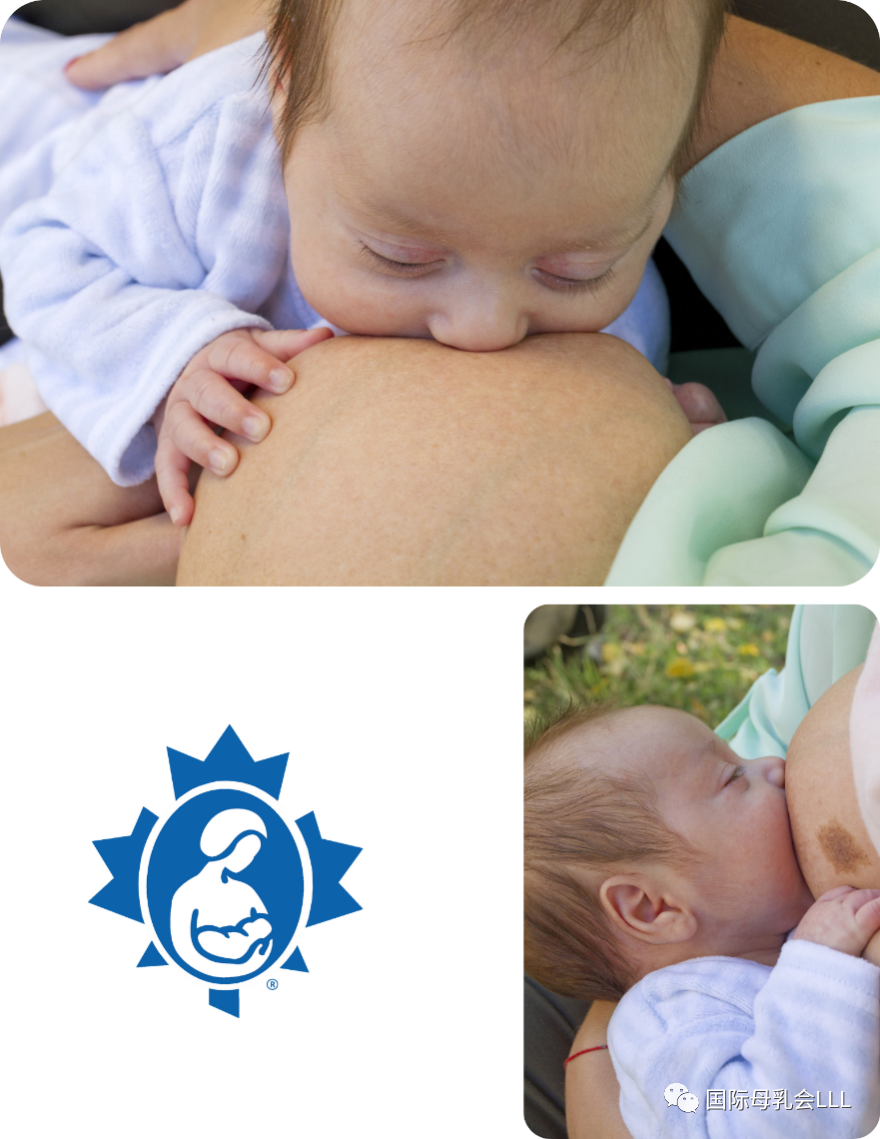


几乎每个产后妈妈都可以通过正确的信息和支持来建立和维持良好的奶量。
如果您担心宝宝的体重增长问题,请医疗保健专业人员、医生或助产士对您的宝宝进行检查。

要建立良好的奶量,重要的第一步是在婴儿出生后的第一个小时内开始母乳喂养。之后,让您的宝宝在最初几天和几周内频繁、无限制地吃奶。新生儿通常大约(平均)每2至3小时吃一次奶,或在24小时内至少吃奶8至12次。
偶尔,婴儿每天吃奶次数较少也能茁壮成长,但是需要监测他们的体重以确保适当的增重。许多婴儿甚至会需要更频繁的哺乳。
哺乳时段在一天中可能不是均匀分布的。有些婴儿会密集地吃几顿奶,然后睡得更久。乳汁分泌是一种“供求”关系。宝宝喝的母乳越多,身体分泌的乳汁就越多。
分娩后,立即要求将婴儿放在您的腹部,刚好在乳房下方进行肌肤接触。助产士可以在婴儿放在您身上时擦干婴儿,然后用一条轻薄干燥的毯子把婴儿盖住。不应擦干婴儿的手,因为您乳头的气味与婴儿手上的气味相似,这将有助于婴儿找到您的乳头。
如有需要,把自己调整到一个舒适的半躺姿势。要求将宝宝放在您的身体上不受干扰至少一小时或直到第一次喂养结束。只要有时间和耐心,大多数婴儿都可以自行爬到胸部,并在第一次喂奶时成功自主含乳。(请参看全球健康媒体的以下视频:https://globalhealthmedia.org/videos/breastfeeding-in-the-first-hours-after-birth/)或点击“阅读原文”观看。
婴儿出生后第一次吃到的母乳叫初乳,它是您的身体在怀孕的最后几个月里开始分泌的。它富含抗体和其他保护因子。少量的初乳可以让您的宝宝有机会学习如何吮吸,而不会一下子因大量的母乳应接不暇。
胎盘的娩出向身体发出信号开始生产成熟的乳汁,而到产后第3-5天开始“下奶”时奶量会显著增加。
将您的身体视为婴儿的自然栖息地会有帮助。不仅在产后即刻,而且在产后数周、甚至数月内保持与宝宝肌肤接触也是有益的。与您的肌肤接触有助于宝宝在学习母乳喂养时保持放松。
宝宝可以通过触觉和嗅觉找到乳头并自主含乳。肌肤接触时间有助于调节宝宝的体温和心率。它还会提高促进母乳分泌的荷尔蒙水平。

含乳良好时,您的婴儿需要大口含乳,轻柔地将您的乳头拉伸到软腭部位,这样一来您的宝宝能够有效地吸出乳汁。
这确保了您的婴儿能得到足够的母乳,而您的身体也会收到信号,继续制造更多的母乳。深含乳还可防止乳头被舌头和硬腭挤压。较浅的含乳经常会导致乳头疼痛。
有一小部分婴儿,由于舌系带过紧, 舌头就会受到限制。因此,婴儿可能无法将乳头足够深地拉入嘴里。
如果尝试改善宝宝的含乳后仍有疼痛,建议您寻求国际认证哺乳顾问(IBCLC)的帮助。如有必要,您可咨询擅长诊断和治疗舌系带过短的医护人员。
留意“喝”和“吮吸”之间的区别很重要。吞咽是您的婴儿正在喝母乳的一个迹象。吮吸时,婴儿的下巴会上下移动,但当婴儿含着一大口母乳时,婴儿的下巴会下降,并有较长的“停顿”以便吞咽。您可能会听到婴儿吞咽后在呼气时的“咔”声。
如果吞咽速度减慢,当婴儿开始吮吸时,您可以用整个手轻轻挤压或按压乳房,这将增加母乳流量,并鼓励您的宝宝继续吃奶。当乳汁流动减慢时,您的宝宝可能希望继续吮吸以寻求安抚。这对婴儿和母亲来说都是非常愉快的。

每个宝宝都是独一无二的,所以观察宝宝,知道什么时候该喂奶很重要。在您的婴儿出现饥饿迹象时进行喂奶被称为“基于提示的喂奶”(也就是按需喂养)。
您的宝宝饿了的迹象包括:
烦躁不安、寻乳(头转向您的胸部)、头在您的胸前摆动、吃手和舔嘴唇
哭泣是饥饿晚期的信号,如果您等到宝宝很饿,可能会发现宝宝太烦躁,无法有效地衔乳。
刚出生的头几天,婴儿在乳汁流出前通常会经历衔乳和突然松开乳房,来回反复几次。最终,您的宝宝将学会一次就衔乳成功,吮吸并等待乳汁流出。
随着您对宝宝的了解, 您也将熟悉哺乳的规律。当您回应您宝宝的提示时,您的身体会收到信号,分泌宝宝所需的奶量。您的宝宝也学会了相信他们的需求会得到满足。
如果您的婴儿在两次喂奶之间经常睡眠超过三个小时,并且体重增长不佳。则可能需要在白天每隔两个小时唤醒他进行喂奶,直到您的奶量充分建立为止。
注意宝宝睡着时的身体动作。这是浅层睡眠的表现。与深层睡眠相比,您可以更容易地唤醒处于浅层睡眠的宝宝。
温和地唤醒宝宝的方法包括:
(相关链接:https://www.muruhui.org/?p=11834)
抱着宝宝肌肤相亲
打开包被或脱下宝宝的衣服
竖着抱宝宝
移动宝宝的胳膊和腿或者揉他的脚
调暗灯光
用湿布擦拭宝宝的脸
和宝宝说话,把几滴初乳放进他的嘴里品尝,用半躺式姿势鼓励他衔乳。(半躺式链接:https://www.muruhui.org/?p=11897)
每次喂奶时提供双侧乳房以确保充足的奶量很重要,尤其是在早期。只要您看到宝宝活跃地吮吸和吞咽,就让您的宝宝继续待在第一个乳房上。
当吮吸速度减慢时,您的婴儿可能会主动离开乳房,或者您可以松开衔乳。这通常是更换尿布或轻轻地将婴儿直立放在胸前拍嗝的好时机。再提供第二个乳房。
大多数婴儿会从第二个乳房吃一些母乳,有些会吃很多。偶尔,您的宝宝可能根本不想再吃。这有时被描述为“第一道是主菜,第二道是餐后甜点。”下次喂奶时,先提供第二个乳房。
宝宝喝的母乳越多,妈妈身体分泌的乳汁就越多。这就是为什么遵循上述提示以确保充足的奶量如此重要。
但同样重要的是要知道供给和需求也可以反向运行。如果补充配方奶粉,您的身体将不会收到在第二天分泌同样多母乳的信号,这将导致奶量减少。如果您需要补充配方奶粉,您需要用手或吸奶器将乳汁从乳房中移除,以刺激您的身体在第二天产出更多的乳汁。当您这样做的时候,您可能不会得到很多奶,但是您的身体仍然会收到制造更多乳汁的信号。
如果您试图将宝宝的喂奶间隔拉开,比宝宝想要的更长,奶量也会减少。让您的宝宝决定两次喂奶之间的间隔时间是有用的。通常在婴儿2-3个月大的时候,您的婴儿在两次喂奶之间的时间可能会更长,在乳房上的时间能会更少。这是因为他们能够比以前更快地移除乳汁。
如果您的宝宝持续增重良好,说明您的乳汁能满足宝宝的需求。如果您的婴儿增重不足, 请咨询国际认证哺乳顾问(IBCLC)以了解资讯和寻求帮助。

大多数母乳喂养的婴儿不需要安抚奶嘴,因为他们在吮吸乳房时自然会获得足够的安抚。安抚奶嘴是为奶瓶喂养的婴儿发明的,因为喂饱后,他们可能需要更多的时间来吮吸。
但在母乳喂养中,安抚吸吮是自然发生的,因为母乳在哺乳快结束时流速会变慢,这给了宝宝时间进行安抚性吮吸,而不是为了吸到更多的奶。母乳喂养可以同时满足饥饿和吸吮的需求。
如果您在最初几天或几周内使用安抚奶嘴,您可能会错过宝宝的喂养信号。这可能会延迟下一次喂养,或者您的婴儿可能会完全错过下一次喂养。这可能会影响产奶量和婴儿的体重增加。
如果您还是想用安抚奶嘴,最好至少等待一个月再使用。在婴儿学会母乳喂养之前给他们安抚奶嘴或奶瓶可能会让他们感到困惑。给您的宝宝一个机会吧,一次只学一件事。

在最初的三个月里,您的宝宝会经历三到四次猛长期。此时通常需要非常频繁哺乳两到三天。遵循宝宝的提示,当宝宝想吃奶时尽可能频繁地喂奶,您的奶量也会因此增加,以满足宝宝的成长需求。
有时母乳喂养会因为种种原因而起步艰难。鼓舞人心的是,我们知道通过遵循这些提示,您可以增加奶量,改善宝宝的增重,同时还能保护哺乳关系。
通过频繁的哺乳,您的宝宝可能会因为靠近您的身体和听到您的心跳而感到安全和舒适。这是正常的,有助于支持健康发育。您的宝宝也可以通过哺乳,满足吮吸的需求。满足这些需求不会宠坏您的宝宝。它将教会您的宝宝相信您会让他们安全舒适。
国际母乳会聚会是能够帮助您寻求他人支持的绝佳地方。国际母乳会的哺乳辅导是经过培训的志愿者,她们可以帮助您享受母乳喂养的时光。关注“国际母乳会-LLL”微信公众号、视频号或访问www.muruhui.org了解我们的聚会信息和其他哺乳资讯。
Almost everyone giving birth can establish and maintain a good milk supply with the right information and support. When you understand how your body and your baby’s body work together to build your milk supply, it is easier to avoid choices that can negatively impact milk production. The hours and days after your baby’s birth are very important in getting things off to a good start. But even with a difficult start, milk supply can be improved in the early weeks. If you are concerned about your baby’s weight gain, have your baby checked by a healthcare professional, doctor or midwife.

An important first step in establishing a good milk supply is to breastfeed, or chestfeed, your baby within the first hour after birth. After that , allow your baby frequent, unlimited access to your breast in the early days and weeks. Newborns usually feed about every two to three hours (on average), or at least 8-12 times in 24 hours. Occasionally, babies can thrive on fewer feedings per day but they should be monitored for appropriate weight gain. Many babies nurse even more frequently. Nursing sessions may not be spaced evenly throughout the day. Some babies cluster several feeds together and then sleep for a longer stretch. Milk production is a “supply and demand” relationship. The more milk your baby drinks, the more milk your body will produce.
Immediately after birth, ask for your baby to be placed skin-to-skin on your belly, just below the breasts. Your baby can be dried off by the birth attendant while on your body, and then covered with a light, dry blanket. Your baby’s hands should not be dried. The smell of your nipples is similar to the smell on your baby’s hands and this will help your baby to find your nipples. If needed, adjust yourself into a comfortable reclined position. Ask that your baby be left undisturbed on your body for at least an hour or until after the first feeding is finished. Given time and patience, most babies can make their way to the chest and latch themselves for this first feeding. See the following video by Global Health Media.
The first milk the baby gets after birth is called colostrum, which your body begins producing in the last few months of pregnancy. It is rich in antibodies and other protective factors. The small quantities give your baby a chance to learn how to suckle without being overwhelmed by large volumes of milk. The delivery of the placenta signals to the body to begin producing mature milk and by day 3-5, the milk “comes in” and the volume increases substantially.
It can be helpful to think of your body as your baby’s natural habitat. It is beneficial to hold your baby skin-to-skin not only during the immediate postpartum period but for weeks, and even months afterwards. Being skin-to-skin with you helps your baby remain calm while learning to breastfeed. Using the senses of touch and smell, your baby can find the nipple and latch on. Skin-to-skin time helps to regulate your baby’s temperature and heart rate. It also heightens your hormones that are involved in milk production.
With a good latch your baby takes a large mouthful of breast which gently stretches your nipple to the soft part of your baby’s palate. When this happens, your baby is able to effectively remove the milk. This ensures that your baby gets plenty of milk and your body gets the message to keep making more milk. A deep latch also prevents the nipple from being pinched by the tongue and the hard palate. A shallow latch often results in sore nipples. Please Click “Read more” to read the original article Positioning and Latching for more information on achieving a comfortable latch. In a small percentage of babies the tongue is restricted because of a tight frenulum or tongue tie. Because of this the baby may not be able to pull the nipple deeply into the mouth. If the latch is still painful even after trying to improve it, you are encouraged to seek the help of a professional International Board Certified Lactation Consultant (IBCLC). Then, if necessary, you may want to consult with a healthcare professional who specializes in diagnosing and treating tongue ties.
It is important to note the difference between “drinking” and “sucking”. Swallowing is a sign that your baby is drinking the milk. Your baby’s chin will move up and down when sucking but when there is a mouthful of milk your baby’s chin will drop with a longer “pause” in order to swallow. You may hear a “kah” sound as the baby breathes out after a swallow. If swallowing slows down, you can gently squeeze or compress your breast with your whole hand when your baby starts sucking. This will increase milk flow and encourage your baby to keep drinking. Your baby may want to continue sucking for comfort as the milk flow slows down. This can be very pleasant for both baby and mother.
Every baby is unique and so it is important to watch your baby to know when it’s time to feed. Feeding when your baby shows signs of hunger is called “cue-based feeding”. Some cues that your baby is hungry are: restlessness, rooting (head turning towards your chest), head bobbing on your chest, mouthing hands and licking lips. Crying is a late hunger cue. If you wait until your baby is hungry you may find that your baby is too upset to be able to latch effectively. In the early days it is common for babies to latch and pop off several times until the milk starts flowing. Eventually your baby will learn to latch once, suck and wait for the milk to flow. You also will begin to recognize patterns in your nursing sessions as you get to know your baby. When you respond to your baby’s cues, your body gets the message to make the amount of milk that your baby needs. And your baby learns to trust that their needs will be met.
If your baby regularly sleeps more than three hours between feedings and is not gaining well, he may need to be awakened for feedings around every two hours during the day until your milk supply is well established. While your baby is sleeping, watch for movement. This is a sign of light sleep. You can wake your baby more easily from a light sleep than from a deep sleep. Gentle ways to wake
your baby are:
holding your baby skin-to-skin
unwrapping or undressing your baby
holding your baby upright
moving your baby’s arms and legs or rubbing his feet
dimming the lights
wiping baby’s face with a damp cloth
talking to your baby putting a few drops of colostrum into his mouth to taste
using the laid-back position to encourage him to latch. (Click “Read more” to read the original article Positioning and Latching )
Offer both breasts at each feeding It is important to offer both breasts at each feeding, especially in the early days in order to ensure a plentiful milk supply. Let your baby stay on the first breast as long as you see active sucking and swallowing. When the sucking slows down, your baby may come off the breast or you can release the latch. This is often a good time to do a diaper change or gently place your baby upright on your chest to encourage a burp. At this point offer the second breast. Most babies will take some milk from the second side and some will take a lot. Occasionally, your baby may not want any at all. This is sometimes described as “the first side is the main course and the second side is dessert.” At the next feeding, offer this second breast first.
The more milk your baby drinks, the more milk your body will make. This is why it is so important to follow the tips above to ensure a plentiful milk supply. But it is important to know that supply and demand can work in reverse as well. If supplemental formula is introduced, your body will not get the message to make that amount of milk the next day. This will lead to a decrease in your supply. If you need to supplement with formula, it is important to express milk from your breasts, by hand or with a breast pump, to stimulate your body to produce more milk the next day. You may not get much milk when you do this, but your body will still get the message to make more milk.
Milk supply can also decrease if you try to space your baby’s feedings farther apart than your baby wants. It’s helpful to let your baby decide when to go longer between feedings. This often happens around 2-3 months of age. Your baby may go longer between feedings and spend less time at the breast. This is because they are able to remove the milk much faster than they used to. If your baby continues to gain well and then your body is making what your baby needs. If your baby is not gaining well, consult an International Board Certified Lactation Consultant (IBCLC) for information and support.
Most breastfed babies don’t require a soother because they naturally get enough comfort sucking at the breast. Soothers were invented for bottle fed babies because, when full, they may need more time to suckle. During breastfeeding, suckling happens naturally because the milk flows more slowly at the end of a feeding. This gives the baby time to suckle for comfort and not get a lot of milk. Hunger and sucking needs are both met by breastfeeding.
If you use a pacifier in the early days and weeks, you may miss your baby’s cues to feed. This may delay the next feeding, or your baby may completely miss the next feeding. This could affect milk production and baby’s weight gain.
If you find that you want to use a soother, it is best to wait for at least a month before introducing it. Giving babies soothers or bottles before they have learned how to breastfeed can be confusing for them. Give your baby a chance to learn one thing at a time.
Three to four times in the first three months your baby will go through growth spurts. This usually involves very frequent feeding for two to three days. Follow your baby’s cues and feed as often as your baby will go to the breast and your milk supply will increase to meet your baby’s growing needs.
Sometimes breastfeeding gets off to a difficult start for one reason or another. It can be encouraging to know that by following these tips you can increase your milk supply and improve your baby’s weight gain while also protecting the nursing relationship.
Your baby may nurse often because of the feeling of security and comfort from being close to your body and hearing your heartbeat. This is normal and helps to support healthy development. Your baby may also nurse to satisfy the need to suck. Meeting these needs will not spoil your baby. It will teach your baby to trust that you will keep them safe and comfortable.
www.lllc.ca/establishing-your-milk-supply

翻译:国际母乳会加拿大
审阅:敏怡,Lynn, Marien
编辑:李幸、沐凡



中国移动手机和宽带用户可访问:
muruhui.com 或muruhui.cn
获取更多资讯

本篇文章来源于微信公众号: 国际母乳会LLL
